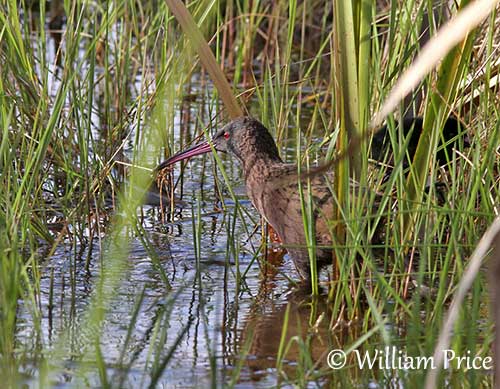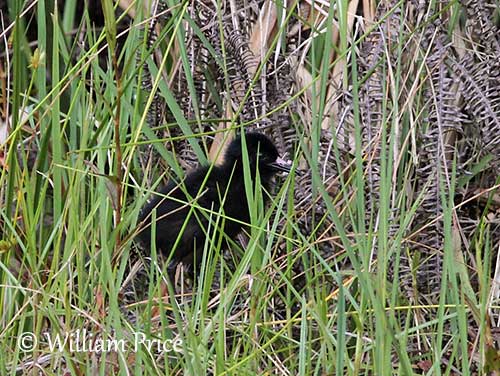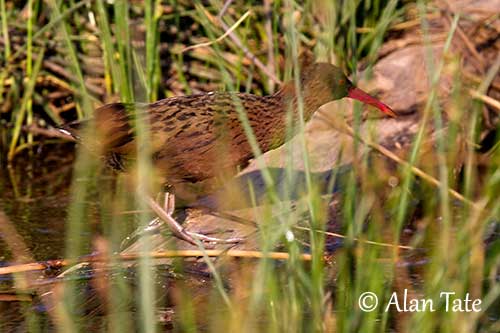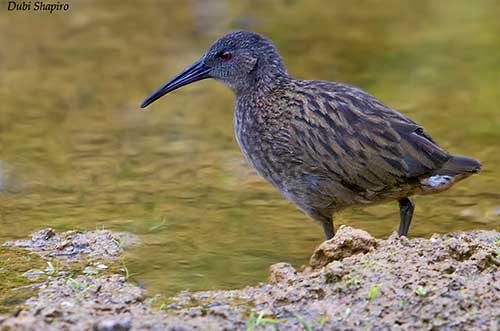
In emergency situations, they may swim and dive to escape a predator. They are fed by both parents, and generally, the fledging period of rails is 4-8 weeks depending on the species.
PROTECTION / THREATS / STATUS:
The Madagascan Rail is vulnerable to habitat loss through transformation of aquatic and wet forest habitats for agriculture expansion and logging. It is present in several protected areas.
The population is estimated at 2,500/10,000 individuals (2002) and is suspected to be decreasing at moderate rate.
The Madagascan Rail is currently listed as Vulnerable.
Fr: Râle de Madagascar
Ang: Madagascan Rail
All: Madagaskarralle
Esp: Rascón Malgache
Ita: Porciglione del Madagascar
Nd: Madagaskarwaterral
Sd: madagaskarrall
Mal: Kiky, Kitsiakely, Tsikea, Voronondrika
Photographers:
William Price
PBase-tereksandpiper & Flickr William Price
Dubi Shapiro
Dubi Shapiro Photo Galleries & Dubi Shapiro's Pictures on IBC
Alan & Ann Tate
AA Bird Photography
Text by NicoleBouglouan
Sources :
HANDBOOK OF THE BIRDS OF THE WORLD Vol 3 by Josep del Hoyo-Andrew Elliott-Jordi Sargatal - Lynx Edicions - ISBN: 8487334202
Rails: A Guide to Rails, Crakes, Gallinules and Coots of the World Par Barry Taylor
Birds of Madagascar: A Photographic Guide By Pete Morris, Frank Hawkins
Madagascan Rail
Rallus madagascariensis
Gruiformes Order – Rallidae Family
INTRODUCTION:
The Madagascan Rail is endemic to Madagascar where it occurs in the eastern wetlands. Like all Rallidae, it is very secretive and remains within the dense marshy vegetation. It is rarely seen in open areas. It is usually more heard than seen, and its loud display call is unmistakable.
The Madagascan Rail is currently listed as Vulnerable.
DESCRIPTION OF THE BIRD:
Biometrics:
Length: 25 cm
Weight: about 148 g
The Madagascan Rail adult has olive-brown upperparts with blackish streaks, including on the upperwings. Crown, nape and hindneck are tinged vinaceous. Forehead, face, chin and throat are grey, whereas ear-coverts are dull vinaceous.
On the underparts, foreneck and neck sides, breast and upper flanks are dull vinaceous, but breast sides and rest of flanks are brighter, with blackish streaks (mainly on breast sides). Lower flanks, belly and undertail-coverts are dark olive-brown with narrow, indistinct whitish bars. The outer undertail-coverts are white.
The long, down-curved bill is pinkish with dark culmen. The eyes are red. Legs and feet are greyish-brown.
Male and female have similar plumage, but the male is larger with longer bill.

The juvenile is duller, with more olive-brown than grey, whitish chin and throat, mostly dull buff-brown breast and upper flanks (not vinaceous).
The immature has brownish bill and brown eyes.
RANGE:
The Madagascan Rail occurs in the eastern side of Madagascar, E to the high plateau.
HABITAT:
The Madagascan Rail frequents marshes with grass, reeds and sedges, and river margins. It can be seen at forest edges in grassland, and it favours the dense grassy vegetation in wet forest. It can be seen from sea-level up to 1800 metres, but mostly at high elevation.
CALLS AND SONGS: SOUNDS BY XENO-CANTO
The Madagascan Rail has several calls given during the day from the vegetal cover. When flushed, it gives a sharp “tsi-kia”. The other calls include a sharp, high-pitched “kia”, a frog-like grunt “grrr-grrrrek” and a clicking “tsick”. It also gives a series of fairly high-pitched notes, falling in pitch and descending slightly. This phrase is probably used as advertising call. We can also hear a loud, car-alarm “eeoo-eeoo-eeoo-eeoo”.
BEHAVIOUR IN THE WILD:
The Madagascan Rail feeds mainly on invertebrates. It probes the mud with the long, decurved bill while walking quietly in the dense marshy vegetation. But as male and female have different bill length, they probably have different foraging behaviour.

The breeding behaviour is poorly known. The Madagascan Rail is usually seen alone or in pairs. Rails are usually monogamous with pair-bonds lasting at least one season.
Calling probably increases during the establishment of the territory and the beginning of the breeding activities. Pair-formation and courtship behaviour are poorly known, but courtship feeding and allopreening are common. The copulation often follows some aggressive chases. But sexual displays are usually limited in Rallidae. However, the loud “klee killee klee” call given during the day is probably used to attract a female.
The Madagascan Rail is suspected to be possibly migratory, but there is no evidence of movements.
Island birds are usually poor fliers and most of them are flightless or nearly so.

